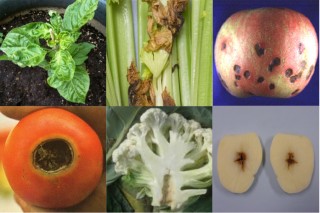Let’s Talk About Calcium
Calcium is an essential nutrient that allows plants to grow, develop, remain healthy and reproduce optimally to form seeds or fruits. Although it’s considered a secondary nutrient, a plant’s need for calcium can be as high as its needs for primary nutrients such as nitrogen and potassium.
Calcium is one of the main components of the cell wall and promotes vigorous roots, better nodulation, stronger stems, and healthy tissues in the leaves, flowers and fruits. Essential for the proper functioning of growing points, particularly root tips and nodules, calcium aids in cell division, forms compounds which strengthen cell walls, supports the function of cell membranes and helps control enzyme activity and the metabolism of starch.
Calcium is also important for the uptake and metabolism of nitrate and phosphorus and is a key element in preventing and controlling certain diseases (i.e. Sclerotinia white mold) and triggering plant’s defense responses to diseases and pests.
Calcium Deficiency
All crops are sensitive to calcium deficiency, especially fruits, vegetables and pod crops. Symptoms are most commonly observed when plants are young and growing rapidly, or when they are setting flowers or developing fruits.
Calcium deficiency can result in a variety of physiological disorders. Depending on the crop, this can include stunted roots, abnormal development of terminal buds and root tips, deformed leaves, leaves that do not open properly, thinning of the flowers, chlorosis and leaf tip necrosis. In tomatoes and peppers, a deficiency can cause blossom and end rots; in apples, bitter pit or hollow heart; and root vegetables, such as potatoes and carrots, may have poor skin finish. Soft fruits deficient in calcium encounter bruises during harvest and do not preserve very well in storage.

Calcium availability can be affected by low soil pH, a high rate of nitrogen application, or an unfavorable balance of calcium, magnesium and potassium. Deficiencies can occur in the plant even when calcium levels in the soil are high, due to an insufficient supply to the plant tissues because calcium is immobile once fixed.
Calcium in the Soil
The best way of determining calcium levels in the soil is through a soil test.
Examining the calcium levels, as well as the percentage in the base saturation (70-80%), should also provide guidance as to what calcium source to use, as it affects pH and the uptake and availability of magnesium (Mg) and potassium (K). For example, using calcium carbonate (lime) on a high pH soil is less advisable than on a low pH soil. Inversely, the use of calcium sulfate (gypsum) is recommended on high pH soils or soils with high content of Mg.
In low pH soils, calcium can help to counter the negative effect of aluminum on root growth and help re-adjust pH. Similarly, applied on soils with salinity issues alongside humic and kelp, calcium helps displace sodium to restore the uncropped areas of the field and put them back into production. On high Mg soils, the use of calcium helps loosen soil aggregates and facilitates water penetration and drainage. Calcium can also be used on lighter and sandy soils to help grow high value crops, such as fruits and vegetables.
Adding Calcium
Depending on the source, calcium comes with other nutrients, such as sulfur (i.e. gypsum), potassium (i.e. wood ash, CKD – Cement Kiln Dust), magnesium (i.e. dolomite), phosphate (i.e. rock phosphate, bone meal) or other essential nutrients (i.e. azomite) and a grower chooses the type depending on their objective: increasing pH (known as liming), reducing the effect of aluminum, reducing the effect of high Mg, etc.
These fertilizers are typically applied onto the soil and mixed in to provide calcium over time. However, if the crop has a high demand for calcium (i.e. fruits, vegetables, pod crops) or prone to show calcium deficiency, one may want to consider foliar application of calcium to promote health and preserve yield and quality.
Bear in mind that calcium is taken up mainly by mass flow and any condition that affects water absorption, like drought, or the activity of stomata or transpiration, such as high temperatures or humidity, reduces the availability of calcium. In addition, as a structural element, calcium is not mobile in the plant and cannot be translocated from older tissues to the younger growth, flowers and fruits or seeds. For this reason, a constant supply is often recommended for this nutrient.
OMEX Can Help
OMEX offers a wide range of Primers, Starters, Foliars, PGRs, Biologicals and Biostimulants that contain calcium to help optimize growth and development of crops in ideal and less than ideal conditions.
- Pulse Primer, Pulse Pak and Primer Soybeans are widely used on pulse crops, soybeans and vegetables planted from seed to increase root biomass and nodulation, initiate a good suberization after the cutting, and provide a good supply of calcium for the early season growth and development.
- Gypflow (liquid gypsum) is also available for those situations where calcium and sulfur are required.
- OMEX has recently developed Sequestri-Cal – a flavonoid sequestered calcium that can be tank-mixed with phosphate.
- P3 (foliar) is another calcium product available for application with herbicide on pulse crops to reduce stress and avoid stalling and delays in maturity and can be applied with Cytokelp which also contains calcium to encourage branching or prolong flowering period. This product can also be applied after a hailstorm with boron (i.e. Super B) to provide a faster crop recovery.
- CN9, CalMax, CalMax Complete or Organomex can be applied in conventional agriculture and in organically-certified operations to supplement calcium to the soil or through the foliage, to prevent or correct deficiencies, promote health, and improve the quality, skin finish and storability of fruits and vegetables.
Talk to your local Ag Retailer or get in touch with your OMEX representative to learn more about the products and solutions that can help you meet the calcium needs of your crops.
